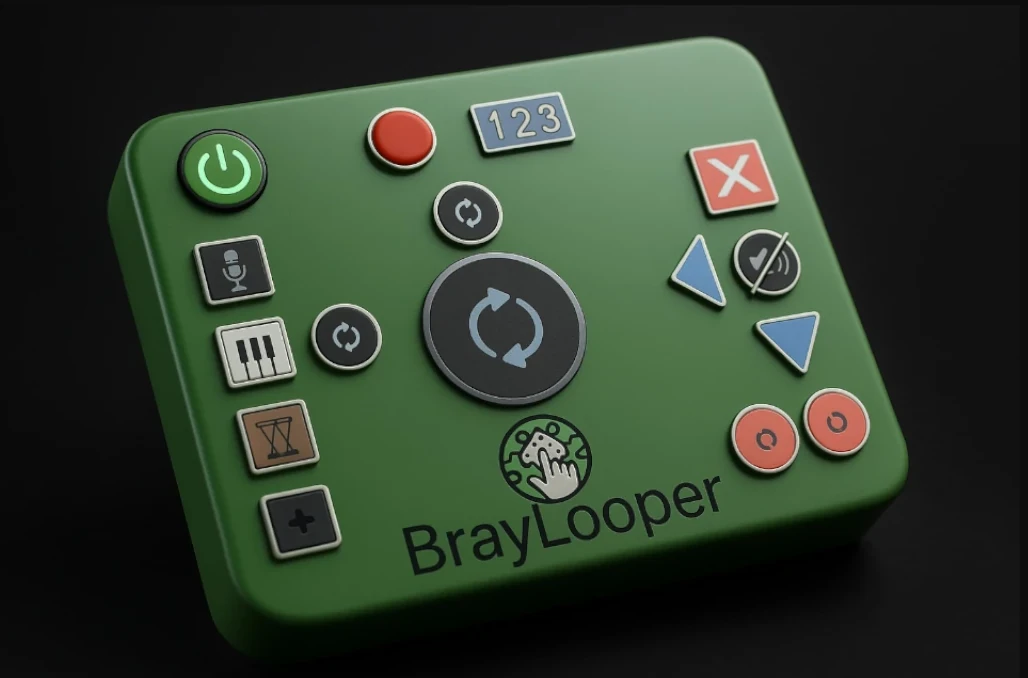Interactive, Inclusive & Intuitive Technology for Music Makers
"The magic of the music seems to light the way"
— John Lennon
I am the co-founder of the BrayLoop project, and this project was born not only out of frustration but also out of inspiration and hope. Let me tell you what I mean:
The frustration came from the fact that, in order to use a DAW (Digital Audio Workstation), you need to perform many actions with the keyboard and mouse to actually start recording music, create layers and build a more complex sound with moments and feelings that grow and decrease, basically a song or a live looping session. We all know of the existence of MIDI controllers, some more useful than others depending on your workflow, but also they tend to rely on visual feedback or the controller has too many or too few pads, knobs, and buttons, falling short to adapt to your specific style and DAW of choice.
Also, I started in music by using GarageBand, and I can say with no doubt that it is a ridiculously good and capable piece of software to be a free DAW (or no extra investment DAW once you get an iPhone or MacBook). Sadly, it does not support MIDI mapping functions, you have to rely on shortcuts if you want to have a bit more fluid experience. This was my case when I started, with a lot of enthusiasm to make music but not enough money or knowledge to invest in something like Logic, Ableton, or any other professional DAW. But still (later I found out) when using those powerful programs, you can still experience the dependency of some shortcuts, mouse drags, and screen feedback, even if you have those fancy and officially integrated class-compliant controllers.

Now, let me tell you about the inspiration. I have a condition with my sight. The right eye of mine is able to capture light, but it has a hard time focusing a single point, and because of that, all my life my brain has been focusing on information coming from the other eye, which is the one that works better. So the right eye alone is not able to do basic day-to-day tasks like reading, using the computer or phone, or any other program on them.
One day a doctor made me realize something, he showed me a perspective that started with a hypothetical worst case scenario for me and my vision, but then inside of me, it was immediately translated to many more people, which sadly for them is not a hypothetical scenario but a reality, and they simply cannot see well or have absolutely no vision with both eyes.
The doctor said to me, “Imagine that you have an accident and your good eye is affected, or you decide to improve your vision in the good eye and the procedure (as any surgery has risks) goes wrong. What would you do? What would be your lifestyle if you want to work and create with computers?”
At first, I had a bad time when I thought of that, but all my imagination started to be centered around something I love: Music. “If I ever go blind, I will have music, so I can embrace that”, I said to myself. Then I started connecting points: How hard will it be for me to use GaragabeBand, if I couldn’t see? What about the visually impaired people, whose entire world is mainly sound and touch? Many of them surely love music, and some would love to make music with all the technology we have now for music making.
Then I knew I was not thinking only about me, looking for life-long possibilities to create, but also I was thinking about musical souls that cannot see light as the target user of today’s technology. I remembered the story and work of master musicians who, although blind, that didn’t stop them from making beautiful and powerful music, even when there were no computers or phones. This project is in part dedicated to them and their legacy.

Our Goal
Brayloop focus is simple: Music is vibration, and modern digital sound technology sometimes introduces a lot of friction and distraction, using visual feedback to control sound. Imagine being able to control a modern DAW and jam and explore music ideas without even looking at a screen, focusing on your interpretation, focusing on the sound and not needing light, just like someone who closes their eyes to really direct their attention to a subset of their senses.
Our Technology
In order to achieve agnostic support, we have developed state-of-the-art software and hardware that allow our designs and their functionality to adapt to any platform and DAW using both MIDI and HID instructions. We created the memory protocol MHIDI, a specification created to optimize memory in the microcontrollers and their routines, expanding the possibilities for both music and other accessibility applications to software control. We also created web, cross-platform and native tools to configure and customize Brayloop devices using serial communication or built-in calibration capabilities, enabling the creation of custom hardware to control numerous music apps on PC, macOS, Linux or mobile platforms like Android and IOS
Devices
BrayLooper
BrayLooper

With the Braylooper you can physically interact and bring live looping (a layer approach and real-time way of making music) to any classic DAW, even if they don’t support MIDI mapping to standard controls when making music.
For controlling effects and virtual instruments, there is the current MIDI controller market, but we know we have potential to bring accessibility to those visually oriented and classic approaches to making music making more fun and enjoyable
